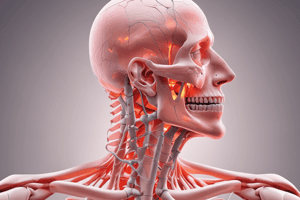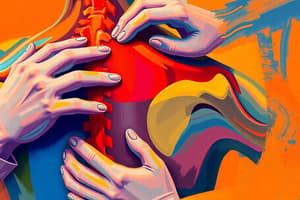Podcast
Questions and Answers
Which imaging technique is best for measuring bone density?
Which imaging technique is best for measuring bone density?
- Ultrasound
- MRI
- CT scan (correct)
- X-ray
Which type of fracture is characterized by a structural break that does not penetrate the skin?
Which type of fracture is characterized by a structural break that does not penetrate the skin?
- Simple fracture (correct)
- Compound fracture
- Comminuted fracture
- Angulated fracture
What complication can occur due to improper healing of a fracture?
What complication can occur due to improper healing of a fracture?
- Compartment syndrome
- Delayed union (correct)
- Sub periosteal hematoma
- Myositis Ossificans
Which of the following fractures is characterized by a fracture line that encircles the bone?
Which of the following fractures is characterized by a fracture line that encircles the bone?
What is the primary method used to assess joint effusion?
What is the primary method used to assess joint effusion?
What characterizes the proliferating zones in bone tissue?
What characterizes the proliferating zones in bone tissue?
What is a common result of hyperparathyroidism on bone tissue?
What is a common result of hyperparathyroidism on bone tissue?
What is one of the main causes of secondary hyperparathyroidism?
What is one of the main causes of secondary hyperparathyroidism?
Which of the following describes the phenomenon of 'Brown tumor' in the context of hyperparathyroidism?
Which of the following describes the phenomenon of 'Brown tumor' in the context of hyperparathyroidism?
What radiological feature is commonly associated with renal osteodystrophy?
What radiological feature is commonly associated with renal osteodystrophy?
What does the 'salt and pepper skull' indicate?
What does the 'salt and pepper skull' indicate?
What is a potential complication of renal osteodystrophy?
What is a potential complication of renal osteodystrophy?
Which of the following conditions can lead to hyperparathyroidism?
Which of the following conditions can lead to hyperparathyroidism?
What is the primary cause of malunion in fractures?
What is the primary cause of malunion in fractures?
Which stage of spondylolisthesis involves 50% forward displacement of the vertebra?
Which stage of spondylolisthesis involves 50% forward displacement of the vertebra?
What is the first radiological sign of osteomyelitis?
What is the first radiological sign of osteomyelitis?
Which of the following is NOT a cause of union problems in fractures?
Which of the following is NOT a cause of union problems in fractures?
Which of these describes the term 'involucrum' in osteomyelitis?
Which of these describes the term 'involucrum' in osteomyelitis?
In chronic osteomyelitis, which structure represents necrotic bone that has become detached?
In chronic osteomyelitis, which structure represents necrotic bone that has become detached?
Which condition represents a forward displacement of one vertebra over another?
Which condition represents a forward displacement of one vertebra over another?
Which zone is NOT part of the physis in bone development?
Which zone is NOT part of the physis in bone development?
What is a primary cause of the improper mineralization seen in rickets?
What is a primary cause of the improper mineralization seen in rickets?
Which radiological feature is NOT typically associated with rickets?
Which radiological feature is NOT typically associated with rickets?
What condition is characterized by the deposition of monosodium urate monohydrate crystals?
What condition is characterized by the deposition of monosodium urate monohydrate crystals?
What age group is most commonly affected by gout?
What age group is most commonly affected by gout?
What would likely NOT be considered a form of phosphate abnormality related to rickets?
What would likely NOT be considered a form of phosphate abnormality related to rickets?
Which sign is NOT commonly seen in patients with acromegaly?
Which sign is NOT commonly seen in patients with acromegaly?
Which of the following best describes the stages of gout?
Which of the following best describes the stages of gout?
What does renal osteodystrophy primarily result from?
What does renal osteodystrophy primarily result from?
Flashcards are hidden until you start studying
Study Notes
Methods of Examination of the Musculoskeletal System
- Plain films used for standard imaging (AP, lateral obliques, and special projections).
- Ultrasound employed for assessing joint effusion.
- CT scan considered the best technique for measuring bone density.
- MRI utilized for detailed soft tissue and bone evaluations.
- Radionuclide studies help assess bone metabolism.
- Angiography examines blood vessels in relation to musculoskeletal conditions.
- Arthrography involves imaging of joints after injection of contrast.
- Fistulography evaluates abnormal connections, typically with imaging.
- Discography assesses intervertebral discs by injecting contrast.
- Arthroscopy is a surgical procedure for joint examination and treatment.
Skeletal Trauma
- Skeletal trauma defined as structural breaks in bone continuity; types include simple (closed) and compound (open) fractures.
- Fracture lines include:
- Greenstick fracture: an incomplete fracture, often in children.
- Transverse or linear fractures: straight across the bone.
- Spiral fracture: rotational or twisting injury.
- Comminuted fracture: bone breaks into multiple fragments.
Complications of Fractures
- Local complications may include hematoma, myositis ossificans, and joint injury.
- General complications may lead to complications like Sudeck's atrophy, transient osteoporosis, and compartment syndrome.
- Common union problems include malunion, delayed union, and non-union.
- Causes of union problems encompass inadequate fixation, soft tissue interposition, infection, and poor patient health.
Spondylolisthesis
- Characterized by forward displacement of one vertebra over another.
- Staging:
- Stage I: 25% displacement.
- Stage II: 50% displacement.
- Stage III: 75% displacement.
- Stage IV: 100% displacement.
- Degenerative spondylolisthesis results from facet arthropathy, while lytic spondylolisthesis occurs due to breaks in the pars interarticularis.
Bone and Joint Infections
- Osteomyelitis is a medullary bone infection causing inflammation and destruction.
- Etiology includes hematogenous spread (especially in children) and direct microbe inoculation from trauma or surgery.
- Acute osteomyelitis can evolve into chronic forms, with potential for Brodie's abscess.
- Radiological signs include soft tissue swelling, metaphyseal destruction in children, involucrum, sequestrum after 30 days, and cloaca formation.
Metabolic and Endocrine Diseases of Bone
- Physis has four zones of cartilage: germinal, proliferating, hypertrophic, and provisional calcification zones.
- Hyperparathyroidism leads to excessive parathyroid hormone production, causing:
- Primary hyperparathyroidism: adenoma, hyperplasia, carcinoma.
- Secondary hyperparathyroidism: occurs as a compensatory mechanism.
- Tertiary hyperparathyroidism: autonomous PTH adenoma after chronic overstimulation.
- Renal osteodystrophy occurs in renal failure, reflecting radiographic changes such as osteopenia and cortical thinning.
Rickets
- Rickets involves improper mineralization of the growth plate and manifests during enchondral bone growth, primarily in infants aged 4-8 months.
- Causes include vitamin D metabolism abnormalities, phosphate metabolism disorders, and calcium deficiency.
- Radiological features consist of poorly mineralized epiphyseal centers, widened epiphyseal plates, metaphyseal cupping, and possible bowing of long bones.
Acromegaly
- Acromegaly arises from excess growth hormone due to eosinophilic adenoma or hyperplasia, leading to enlarged bones and tissues.
- Gigantism occurs when excess growth hormone is present during childhood development.
Gout
- Gout results from the deposition of monosodium urate crystals in tissues, often impacting individuals over 40, primarily males (90% of cases).
- Etiology includes both overproduction (10%) of uric acid and under-excretion of uric acid, which can be primary or secondary.
- Stages include asymptomatic, acute gouty arthritis (mono or oligo-articular), and can occasionally involve multiple joints.
Studying That Suits You
Use AI to generate personalized quizzes and flashcards to suit your learning preferences.




